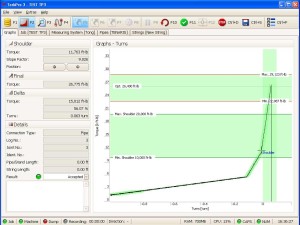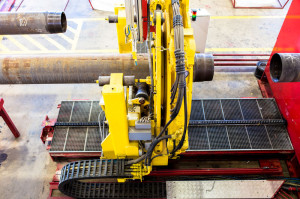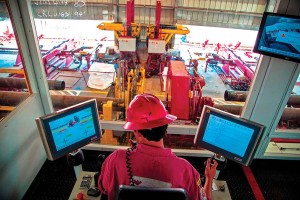Tubular integrity begins with assurance of robust connections
Pre-screening, real-time monitoring drive comprehensive process to manage tubular-running operations
By Scott Sivewright, Weatherford

The integrity of the tubular string is only as good as the connection between each joint. Connection makeup acceptance and accuracy are critical to casing string integrity, which provides a secure mechanical formation barrier for the life of the well. However, it seems that failures at the connection contribute to many of the pipe failures encountered downhole. With casing, tubing and drill pipe accounting for approximately half of the entire cost of the well in some instances, it’s critical to maintain casing and completion tubing integrity through robust and reliable connections.
Ensuring connection integrity is also critical to the integrity of the overall well. This helps ensure a long-term, reliable operation of the well with a corresponding reduction in NPT and costs.
A comprehensive management process around tubular-running services (TRS) and connection integrity has been developed incorporating innovations in mechanized rig systems and connection monitoring tools. Weatherford undertook this development under collaboration with operators and OEMs, as well as guidance from a global network of in-house subject matter experts (SMEs).
Making a solid connection
The ability to ensure gas-tight seals designed to withstand high torque and bending stresses is critical as operations move into ultra-deepwater. Not only must these connections be made up to OEM parameters, they must be made up quickly and safely, with minimal requirement for manual handling. If the connections leak or fail over time, they can be expensive to repair. This typically requires a costly intervention and tubing replacement operation, after which the operator runs the risk of not being able to recover production rates to pre-leak levels.
A connection-integrity strategy has been developed to mitigate the risk of wellbore tubular failure. This process involves having dedicated SMEs engage with the operator at the early stages of well planning. This helps the service provider to gain valuable insight into anticipated well parameters, including geometry and trajectory, flow rates and expected downhole temperatures and pressures. These parameters guide the decision-making process for the metallurgical composition of the tubing string and threads, the type of thread dope to use and the torque-turn requirements to ensure robust and tight connections along the string.
Collaboration continues into the predeployment testing stage. The same equipment and tubulars to be used at the wellsite are evaluated on a test rig onshore. This testing not only uncovers how the tubulars are expected to perform on the rig, but it also gives the TRS team familiarity with the makeup equipment and process that can lead to deployment efficiency improvement. Acceptance criteria for passing these tests vary from job to job, but typical outputs include:
• Making up and breaking out connections multiple times, often to failure or until unacceptable galling is observed, using the same equipment that will be deployed on the rig. During this testing, the OEM parameters for acceptable connection integrity must be met during each makeup;
• Measure body markings made by the handling equipment and ensure that markings do not exceed the maximum permissible values for depth or width;
• Define and agree on the best practice for accepting shoulder dips; and
• Define best practices for applying thread lubricant.

Moving offshore
Once on the rig, the service provider deploys its remotely operated JAMPro Joint Analyzed Make-Up system, which provides real-time monitoring of tubular makeup for each connection. The system comprises several components that, when taken together, help ensure each connection is made up to the torque specifications set forth per well requirements, with no potential leak paths.
Typical components include a turns counter, which measures and records connection turns in increments of 1/1000 of a full rotation, and rotational speed and direction. A dump valve is also deployed to control the torque applied to each connection. When the required torque is reached – measured via a load cell connected to a reaction post on the power tong – the valve diverts hydraulic flow from the tong-operating spool to the return line via a spool cartridge, thus preventing any further turns. The operator can remotely visualize the makeup from the power tong from a remote unit
These separate components are integrated through real-time monitoring and control software, the TorkPro 3, which also records and analyzes torque-turn data from all pipe connections made in the field. The software then compares this data with the latest connection manufacturer requirements to determine the integrity of the connections. It also populates comments of the connection condition on several graphs that inform how well the field data fall within predetermined acceptance criteria.
This data is available in real time to all authorized team members through computers or mobile devices. Such access allows for collaboration between the onshore operations team and offshore crew running the tubular job. It also helps to quickly identify potential connection problems while the operation is still ongoing to minimize the risk of leaks or damage to any connection. The results of each connection makeup are presented in graphical form and interpreted. Reports are generated after each job, and a record is kept for tracking.
Meeting connection criteria
The traditional acceptance criteria provided by interpreting the graphical output from monitoring software includes the final torque applied to the connection. Most OEMs place a standard criterion for final torque to be within 10% of the minimum and maximum torque. The other common criterion is the torque where sealing faces contact – commonly known as shoulder torque – which can be between 5% and 70% of the optimum torque to generate sufficient delta torque.
In increasingly deeper waters and reservoirs, these traditional criteria are not sufficient to ensure long-term reliability of deepwater connections. The torque-turn control software is, therefore, programmed with expanded acceptance criteria that typically include:
• Delta turns, or the turns applied after the connection shoulders to prevent yielding, should typically fall between 0.010 and 0.100 turns;
• Shoulder slope calculations, which provide the change in makeup torque coordinates divided by the delta turns, should fall between 5 and 30 to be considered acceptable; and
• Statistics snapshots and connection overlays enable quick comparisons with historical data and identify any unusual connection profiles.

Realizing results in the field
An operator in the North Sea was looking for a casing-running option that would improve the integrity of an offshore well while also allowing its onshore support team to conduct real-time reviews of tubular makeup. Weatherford’s ATEX-compliant, remotely operated OverDrive casing-running system was deployed along with the joint-analyzed makeup software.
This solution allowed for real-time monitoring and recording of torque-turn data for all connections. The onshore support team was able to operate the makeup system from the office and communicate and collaborate with the offshore crew on changes to the makeup operation, as required. The remotely operated software, integrated as part of the overall casing-running system, improved the overall efficiency of the run and enhanced the safety of rig personnel.
A total 263 casing joints were run into the wellbore without damaging any connection, and the operation was performed without incident.
In another application, an onshore operator in Latin America needed to replace the 7-in. production tubing on a number of wells. Several of the wells had developed holes in the tubing.
Once the old tubing was removed, the replacement tubing – 7-in., 29-lb/ft (43.2-kg/m) premium casing – was run with a remotely operated pick up/lay down casing-feeding system. The system was capable of making connections faster and provided the ability to transmit power and mud flow from the top drive to the casing. The running solution also included a modular internal clamping tool with non-marking jaws to handle and deploy each tubing joint without causing damage. A single-joint compensator was deployed as part of the solution to eliminate the set-down weight from the threaded connections during makeup, reducing the risk of threaded galling and cross-threading.
The system included an integral weight-compensation feature that enabled the operator to improve the efficiency and quality of the premium connection makeup operation and ensured that no connections were damaged or backed out. Further, the automated system for tubular makeup eliminated the need for a stabber in the derrick.
A total of 1,275 connections were made during the operation, with the required torque achieved in each case and no damage to any connection. No recordable incidents occurred.
Cultivating consistent expertise
Responding to industry need for a consistent approach to connection integrity built on best practices, the TRS and SME network has expanded its role. In addition to operational support for each project, the SME plays a key role in technology development and sustaining engineering services.
Regardless of their geographic base of operations, each SME is charged with sharing connection-integrity best practices with colleagues. This ensures that each job is engineered and executed in a consistent manner.
The SME also has access to resources within the service organization that may fall outside the connection integrity specialty. This allows the SME to address other operational problems.
The global SME network also coordinates the development and field-testing of new tubular-connection technologies and standardizes all tubular-running and connection makeup procedures and policies to consistency of deployment.
Finally, to ensure that both end user and service company’s field engineers have the latest information and training in safe tubular make-up operations, the SMEs are charged with developing and updating relevant training material and conducting seminars.
This comprehensive approach to connection integrity incorporates collaboration, thorough pre-screening, automated equipment and ongoing operational support and provides additional assurance that the tubing strings will reliably deliver reservoir fluids to the wellhead.




